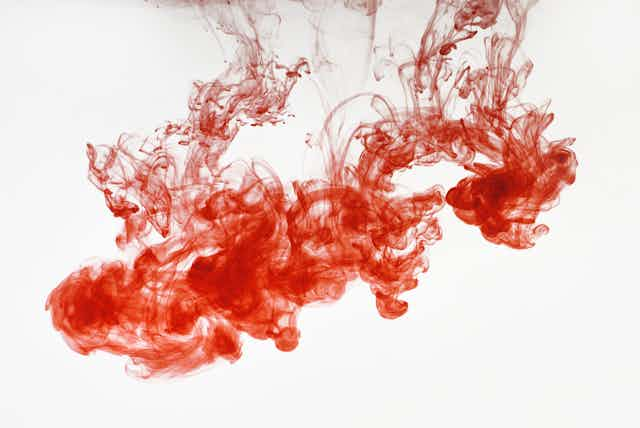This week we’re running a series in collaboration with the Australian Red Cross Blood Service looking at blood: what it actually does, why we need it, and what happens when something goes wrong with the fluid that gives us life. Read other articles in the series here.
There are many molecules on the surface of red blood cells that vary between individuals, and these form the basis of blood groups. The most commonly recognised of these are the ABO blood groups, and Rh antigens (which are signified by the “positive” or “negative” that comes after A, B or O on your blood type).
What you may not know is that there are 34 other blood group systems with more than 300 known variants. These are all classified by the “antigens” found on the surface of our red blood cells. Antigens are molecules (most often proteins, but also carbohydrates) capable of provoking our immune systems to attack.
People also have antibodies - the proteins that attack infections and other foreign bodies. So when a patient needs someone else’s blood transfused into them, we have to make sure they don’t have the type of antibodies that will attack the antigens on the blood the donor has provided for them.
We do this by identifying the blood group the antibody reacts with and then matching blood from donors whose blood type has been extensively tested and established. Additional blood typing is carried out when an antibody to a blood cell antigen has been identified in a patient.

What are some of these blood groups?
The “MNS blood group antigens” were discovered in the 1920s by Karl Landsteiner (the same scientist who discovered the ABO system). This is a complex blood group system found on some of the most important structural proteins on the surface of red cells. It’s common to find antibodies to the M blood group in the plasma of patients, as these are sometimes formed after infection, and testing is required to ensure the patient’s anti-M antibodies do not destroy donated red blood cells.
Another blood group, the “S/s variants”, are named after Sydney, where the blood group was discovered. This blood group is signified by a particular type of molecule on the red blood cells that is a target of the malaria parasite. Interestingly, some people from Africa do not have these molecules on the surface of their cells at all, making them less likely to contract malaria.
Infographic - From animal experiments to saving lives: a history of blood transfusions
A blood group known as Duffy is also associated with infection by another type of malaria (known as Plasmodium vivax). When this protein is absent from the red blood cells, the cells are resistant to infection by the malaria parasite. This protein is absent from the blood cells of 90% of sub-Saharan Africans, conferring malaria resistance on this population. Antibodies to the Duffy antigens are commonly found in a patient’s plasma and are a cause of transfusion reactions if carefully matched antigen negative blood is not given.
The K antigen (colloquially called Kell) was first detected in the 1940s as a result of a woman without the K antigen on her red blood cells being pregnant with a baby with the K antigen on the red blood cells. While almost all women post-partum have antibodies to some antigens found on the baby’s white blood cells, red cell antibodies are less common.

Following the discovery of the K antigen, more antigens were also found in this blood group system, which is a common pattern of discovery in this field. The red cells of 9% of the Caucasian population have the K antigen on their surface. After the Rh antigens, anti-K is the most common antibody found in testing patients prior to transfusion.
Another blood group, Kidd, was named after the patient in whom it was discovered. The Kidd proteins are related to proteins in the kidney that help get rid of waste from the body. For the Kidd blood group it’s very important to avoid damaging reactions, and therefore carefully matched antigen negative blood is given.
How did we discover all these groups?
The most common way these blood groups were discovered was through investigation of patients who had poor outcomes from transfusion. Their plasma has been used to study donors and find blood suitable for transfusion. This would then be used to prevent reactions in patients with similar antibodies. The chain of discovering a problem and then working out how to stop it happening again is the basis of testing blood prior to transfusion.
Although we don’t know the function of all the cell surface molecules that make up the blood group antigens, we do know some of them have functions elsewhere. For example, the Kell antigen is an enzyme (the biological catalysts). Other red cell antigens are involved in the structure of the cell membrane, and the transport of chemicals between the inside and outside of the cell. All antigens should be considered when matching blood for transfusion.
The field of blood group antigens is always growing, particularly with the application of modern genetic sequencing techniques. Using these techniques, the research team at the Australian Red Cross Blood Service have discovered at least three new blood group antigens in recent years, and have also deciphered the blood types of ancient people such as Denisovans and Neanderthals, based on their DNA sequence.
Read other articles in the series:
Essays on blood: why do we actually have it?
From animal experiments to saving lives: a history of blood transfusions
Explainer: what’s actually in our blood?
What can go wrong in the blood? A brief overview of bleeding, clotting and cancer

